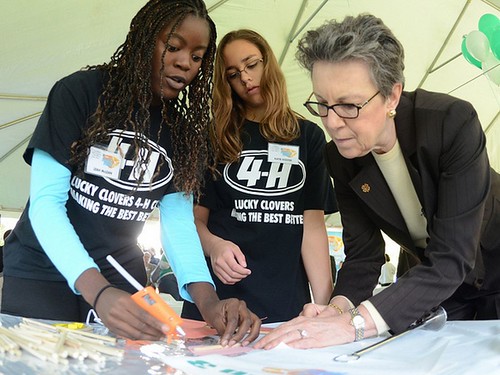
The past eight years have been an extraordinary time for agricultural science, and for the application of new insights from other fields to enhance agricultural productivity and the overall agricultural economy. As the final days of this administration are approaching, it gives me a great deal of pride to look back at what USDA has accomplished in the areas of research and innovation.
Scientific research is a fundamental part of our mission at USDA. But, ultimately, what's behind all the science is people – people who do the research and people who are affected by it. As USDA's Chief Scientist and Under Secretary for Research, Education and Economics, I've met and worked with both as I've traveled across the country and around the world.
I've seen the dedication and innovation of researchers at a USDA laboratory in California as they developed uses for drones and laser-guided sprayers as part of a "precision agriculture" movement. Their work allows the wise, efficient application of water and chemicals – as well as increased crop yields – in drought-ridden areas.
I've seen the confident, solitary efforts of a Cornell University professor in the field of urban aquaponics who, with USDA funding, proved that he can not only raise 10,000 tilapia in fish tanks housed in the unlikely location of a high school basement in midtown Manhattan, but could then recirculate the fish tank water to nourish a thriving edible garden a few floors up in the school building.
And I've seen the eagerness reflected in the faces of two young girls taking part in 4-H National Science Day activities in the nation's capital, applying science and technology skills and equipping themselves to possibly become part of the next generation of leaders in agricultural science.
These people, and so many before them, embody the commitment to scientific innovation that is a major reason why Americans have not had to worry about food security since the Dust Bowl days of the 1930s. To learn more about USDA's important scientific work, I invite you to take a few minutes to take a look at our results over the past eight years in our USDA Medium Chapter 11: Food and Ag Science Will Shape Our Future.
The 21st Century has been referred to as the “Century for Biology,” and we are witnessing the applications of our heightened understanding of genes and gene traits to enhance crops and livestock. These applications, in turn, have been integral to USDA efforts like the transfer of germplasm and new plant varieties to the private sector here in the U.S.
We are helping, through USDA’s partnership with the Agency for International Development and the “Feed the Future” initiative, in delivering UG99-resistant wheat varieties and improving the nutritional content of legumes—two examples of how our research and innovation are being applied to help improve food security around the world.
Our work has been informed by projections that our global population will reach over 9.5 billion people by the year 2050. To adequately feed that number of people would require an almost doubling of the world’s current level of agricultural production and a reduction in food loss and waste, at the same time the amount of farmable land is decreasing. As we continue to learn about the effects of a changing climate, our focus is on sustainably intensifying agricultural production to deliver the array of foods to provide for good health and foods that are free of disease-causing pathogens and toxins.
We have developed a vision of a bioeconomy that by the year 2030 will produce a billion tons of biomass – agricultural residues, grasses, energy crops, forestry trimmings, algae and other sources – that will provide alternative sources of fuel, energy and other bioproducts. We have also focused research on developing agricultural systems that will be able to provide all of these services and be resilient in the face of climate change.
Over the last eight years. We have faced numerous challenges and the results have been remarkable. There is still much to do, but we have left a solid foundation for continuing USDA’s work to support the American agricultural economy, to strengthen rural communities, to protect and conserve our natural resources, and to provide a safe, sufficient, and nutritious food supply for the American people.
